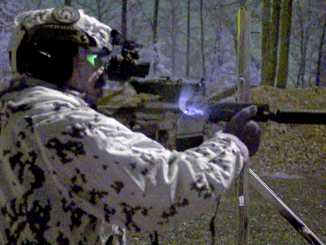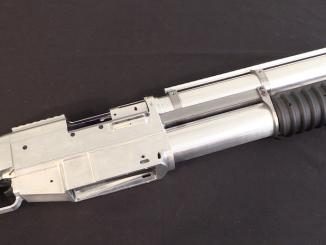The firm of Anitua Y Charola in Eibar, Spain (later renamed Charola Y Anitua) was founded in 1880 or 1881, and their first substantial product was a copy of the American Merwin & Hulbert revolver. They were made with hopes of getting Spanish military adoption, and thus were chambered for the .44 S&W American cartridge instead of the .44-40 Winchester cartridge that the original Merwin & Hulbert used. The military acceptance never did come, but the guns were in production for about 15 years.
An interesting quirk of Spanish patent law was that a product had to be actually produced in Spain in order to qualify for patent protection. None of the major small arms developers had manufacturing facilities in Spain, and so most never bothered to take out Spanish patents – and Spanish gunmakers rampantly copied European and American designs. In this case, though, Anitua took the rather brazen step of patenting the Merwin & Hulbert system them selves in Spain! To make things more interesting, a legal fight then developed between Anitua and the rival company Orbea Hermanos, who claimed to have been making the Merwin & Hulber system first…
Many thanks to Mike Carrick of Arms Heritage Magazine for providing me access to film this example!




Reasonably popular with Spanish officers, who privately purchased their own handguns in the late 19th century. The S&W No. 3 “Russian” was very popular. .44 “Russian” was the Spanish service pistol cartridge prior to 9mm largo.
Actually, oh great one, the grips on your example of a Spanish, M&H knockoff are remarkedly similar to the M&H grips as you can see in the attached photo of my .32 Cal. M&H revolver. One would have to look closely at the markings to verify what version one was looking at.
Otherwise, it was n educational and very enjoyable video as are all your other videos. Thanks for the fine presentation.
[img]https://i.imgur.com/En3GGkqh.jpg[/img]
[img]https://i.imgur.com/IA5mbRXh.jpg[/img]
If they HAD tried to call it a Smith and Wesson then it would be a really wacky patent story.
And perhaps Smith and Wesson might send someone to, uh, deal with the issue, possibly ending with the “patent thief” stuffed into a coffin with a bunch of rocks and then dumped into the Atlantic Ocean?
Smith & Wesson might’ve LIKED to do something about this sort of thing, but in Spain, they were powerless–as they were in most of Europe. They managed to win some small infringement cases against little Belgian makers, but in general just had to take the hit.
While Spain happily copied S&W designs right along with M&H (they built S&W #3s in all variants including Schofields and DAs, M&Ps in varying qualities, whatever would sell), The Belgians did a land-office business in making ‘Brevete’ copies of everything S&W. Even the English and French got in on the act, with everybody ignoring patents as if they didn’t exist. The MOST fun was had by the Russians; After buying 235,000 legitimate S&Ws, the Russians had Ludwig Loewe of Germany ‘reverse-engineer’ the guns and build them there, then got the tooling from Loewe and built them for themselves at Tula, bypassing S&W completely and almost bankrupting the company.
Given the lack of concern that the US had when it came to IP at the time, all you can conclude is that turnabout is fair play. Look up the travails that Charles Dickens went through, trying to get his just dues from publishers here in the US.
IP has been a mess since forever, TBH. I’m also unsure that the patent system is worth the trouble, given all the crap that surrounded the White patents on bored-through cylinders. Sure, the system encourages a certain amount of innovation, but how much does it also choke off? Would we be better off with some sort of system where you could use whatever was out there, but had to at least acknowledge who and what you were borrowing from, then pay them?
The whole issue of software patents and copyrights are another thing entirely. I’ve got disks and disks of stuff done in Describe on OS/2 that I can’t even access any more, and the functionality of that program isn’t replicated anywhere in the Windows ecosystem. Not to mention, the OS/2 native internet browser had a “history” feature that enabled you to research things without having worry about losing entire branches of links you’d visited. Again, nothing I’ve seen in the Windows ecosystem even comes close to that feature’s functionality.
So… Yeah. I’m more than slightly ambivalent about the benefits of the current system of IP protection, and when someone tells me it safeguards inventors and innovation, I just chuckle.
GODFATHER PART 2. Spanish copy of actual M & H?
Spanish Army officers hasn’t a proper regulation revolver, but according to regulations they must use a revolver so they must buy it (as in almost any army). They can choose the model with two constraints, it has to accommodate to the regulation holster and use the 11 mm model 1884 cartridge (a version of .44 S&W Russian). In 1884 the company Orbea Hermanos (Orbea Bros.), the best revolver manufacturer, obtained an official recommendation to officers for its copy of S&W no. 3 DA revolver.
Anitua y Charola also obtained a similar recommendation for his copy of the Merwin, Hulbert & Co revolver in 1888, but was not much used, Spanish officers preferred S&W type revolvers, not only in 11 mm but also smaller versions in 38 cal. Anitua y Charola sold many of his Merwin system revolvers in Mexico.
Muchísimas gracias!